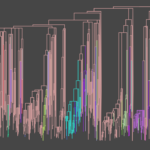Présentation
HIV-1 drug resistance mutations (DRMs) can be dangerous not only on the individual level but also for the whole population. Acquired drug resistance (ADR) appears under drug selective pressure and limits the choice of treatment for the individual in question, while transmitted drug resistance (TDR) limits the treatment choice on the population level. Moreover, in previous studies we showed that in the UK drug resistance is mostly transmitted by treatment-naive individuals [Mourad et al. AIDS 2015], while in West Africa a large fraction of the population is multi-resistant [Villabona-Arenas et al. AIDS 2016]. The rate at which TDR mutations persist is likely to be multifactorial and have been shown to vary considerably for individual mutations [Castro et al. J Infect Dis 2013]. Thus, it is essential to detect TDR clusters and follow the patterns of their evolution over time and in different countries and social contexts, as well as to compare different DRM evolution and detect potential new DRMs.
Using our recently developed ancestral scenario reconstruction tool PastML [Ishikawa et al. MBE 2019, pastml.pasteur.fr], we study ancestral states for presence/absence of common surveillance DRMs in HIV phylogenies. In a tree annotated with PastML, we can discriminate between two types of resistant nodes: (1) those whose parent node does not have the DRM, which correspond to ADR, and (2) those whose parent node is also resistant, such nodes form TDR clusters. In [Ishikawa et al. MBE 2019] we applied this approach to HIV-1 C data from Los Alamos database [hiv.lanl.gov], and showed that the frequency of TDR/ADR patterns varies highly depending on the country: In Africa we found resistant nodes mostly of ADR type, while in higher-income countries with access to antiretroviral therapy, we saw nodes of both types and a high prevalence of transmitted DRMs. We collaborate with the UK HIV Drug Resistance Database [Dunn and Pillay J HIV Ther 2007, hivrdb.org.uk] team to apply these techniques to study TDR/ADR patterns in the HIV-1 sequence data in the UK. We also collaborate with PANGEA consortium [Pillay et al. Lancet Infect Dis 2015, pangea-hiv.org] to study the DRM transmission patterns of HIV-1 in Africa. Lastly, we study the dynamics and resistance spread of HIV-1 epidemics in Cuba in collaboration with the team of Dr Vivian Kourí Cardellá from IPK (Habana) [more details].
Another direction of our DRM studies aim at detecting new DRMs. We have previously applied statistical methods [Villabona-Arenas et al. AIDS 2016] to analyse the DRM repertoire in Africa. We are currently extending this study with machine learning techniques [more details] and statistical analyses of evolutionary convergence and adaptation [more details].



